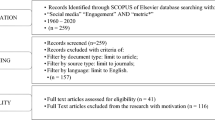Abstract
Large groups of people exhibit social intelligence: coherent behavior directed towards individual or collective goals. This paper examines ways in which such behavior is produced in face to face situations, and discusses how it can be supported in online systems used by geographically distributed groups. It describes the concept of a “social proxy,” a minimalist visualization of the presence and activities of participants in an online interaction that is used to make online social norms visible. It summarizes experience with an implemented system, presents conceptual designs that illustrate the range of situations to which social proxies can be applied, and discusses how to go about designing these types of visualizations.









Similar content being viewed by others
References
Bradner E, Kellogg WA, Erickson T (1999) The adoption and use of “Babble” : a field study of chat in the workplace. In: Proceedings of the 6th European conference on computer-supported cooperative work. Kluwer, Norwell, pp 139–158
Churchill EF, Snowdon DN, Munro AJ (eds) (2001) Collaborative virtual environments: digital places and spaces for interaction. Springer, Heidelberg
Ding X, Erickson T, Kellogg WA, Levy S, Christensen JE, Sussman J, Wolf TV, Bennett WE (2007) An empirical study of the use of visually enhanced VoIP audio conferencing: the case of IEAC. In: Proceedings of the SIGCHI conference on human factors in computing systems. ACM Press, New York, pp 1019–1028
Erickson T, Huang W, Danis C, Kellogg WA (2004) A social proxy for distributed tasks: design and evaluation of a working prototype. In: The proceedings of CHI 2004. ACM Press, New York
Erickson T, Kellogg WA (2000) Social translucence: an approach to designing systems that mesh with social processes. In: Transactions on computer-human interaction, vol 7(1). ACM Press, New York, pp 59–83
Erickson T, Kellogg WA, Laff M, Sussman J, Wolf TV, Halverson CA, Edwards DA (2006) A persistent chat space for work groups: the design, evaluation and deployment of loops. In: The proceedings of DIS 2006. ACM Press, New York
Erickson T, Laff M (2001) The design of the ‘babble’ timeline: a social proxy for visualizing group activity over time. In: The proceedings of CHI 2001. ACM Press, New York
Erickson T, Kellogg WA (2003) Knowledge communities: online environments for supporting knowledge management and its social context. In: Ackerman Pipek, Wulf V (eds) Sharing expertise: beyond knowledge management. MIT Press, Cambridge, pp 299–326
Erickson T, Smith DN, Kellogg WA, Laff MR, Richards JT, Bradner E (1999) Socially translucent systems: social proxies, persistent conversation, and the design of babble. In: The proceedings of CHI 1999. ACM Press, New York
Finn EK, Sellen AJ, Wilbur SB (eds) (1997) Video-mediated communication. Lawrence Erlbaum, Hillsdale
Glasser L, Huhns (1989) Distributed artificial intelligence, vol 2 (Research Notes in Artificial Intelligence). Morgan Kaufman, San Francisco
Goffman E (1963) Behavior in public places: notes on the social organization of gatherings. Doubleday Macmillan, New York
Gordon D (1999) Ants at work: how an insect society is organized. Simon & Schuster, New York
Halverson CA, Erickson T, Sussman J (2003) What counts as success?: punctuated patterns of use in a persistent chat environment. In: Proceedings of the 2003 international ACM SIGGROUP conference on supporting group work. ACM Press, New York, pp 180–189
Milgram S, Liberty HJ, Toldeo R, Wackenhut J (1986) Response to Intrusion into Waiting Lines J Pers Soc Psychol 5(4): 683–689 (Reprinted in Sabini and Silver (eds) The individual in a social world: essays and experiments, 2nd edn., McGraw-Hill, New York.)
Milgram S (1977/1992) The individual in a social world: essays and experiments (2nd edn., Sabini and Silver (eds); originally published 1977). McGraw-Hill, New York
Moors T (2002) The SmartPhone: interactive group audio with complementary symbolic control. In: Proceedings of the 4th international conference on distributed communities on the web (Sydney, Australia, April 3–5, 2002)
Rafaeli S, Noy A (2002) Online auctions, messaging, communication and social facilitation: a simulation and experimental evidence. Eur J Inf Syst, 11(3):196–207. Palgrave MacMillan, New York
Rafaeli S, Noy A (2005) Social presence: influence on bidders in internet auctions. Electronic markets, 15(2). Routledge, London
Smith CW (1989) Auctions: the social construction of value. Free Press, New York
Surowiecki J (2004) The wisdom of crowds: why the many are smarter than the few and how collective wisdom shapes business, economies, societies and nations. Random House, New York
Tufte ER (1990) Envisioning information. Graphics Press, Cheshire
Whyte WH (1988) City: rediscovering the center. Doubleday, New York
Yankelovich N, Walker W, Roberts P, Wessler M, Kaplan J, Provino J (2004) Meeting central: making distributed meetings more effective. In: The proceedings of CSCW 2004. ACM Press, New York
Acknowledgments
Thanks to those involved in the Babble and Loops projects: Erin Bradner, Jason Ellis, Brent Hailpern, Christine Halverson, Wendy Kellogg, Mark Laff, Peter Malkin, John Richards, David N. Smith, Jeremy Sussman, Cal Swart, Tracee Wolf, and several generations of users. And thanks to my IBM colleagues in the Social Computing and Next Generation Web Interface groups for support and inspiration.
Author information
Authors and Affiliations
Corresponding author
Rights and permissions
About this article
Cite this article
Erickson, T. ‘Social’ systems: designing digital systems that support social intelligence. AI & Soc 23, 147–166 (2009). https://doi.org/10.1007/s00146-007-0140-3
Received:
Accepted:
Published:
Issue Date:
DOI: https://doi.org/10.1007/s00146-007-0140-3



